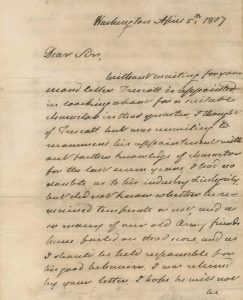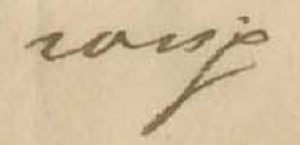By Susan Martin, Processing Archivist & EAD Coordinator
This is the third part of a series about the letters to William and Caroline Eustis at the Massachusetts Historical Society. Click here to read Part I and Part II.

Among the many interesting letters to William and Caroline Eustis at the MHS is one written by Secretary of War Henry Dearborn in Washington, D.C. on 5 April 1807. I’d like to take another one of my deep dives and look at this letter in more detail. It’s a great example of what we archivists often see in historical correspondence: a relatively mundane topic juxtaposed with a very dramatic one.
Dearborn began his letter to William Eustis by informing him of the routine appointment of a man named Lemuel Trescott to be collector of customs at the port of Machias, Maine. Dearborn had asked Eustis for advice about Trescott’s character, and what he heard reassured him. He’d been particularly concerned with the question of temperance, “as so many of our old Army friends have failed on that score.”
So far, so good. But what began as a letter on straightforward official business became, on the second page, an account of the escape and recapture of Vice President Aaron Burr before his trial on charges of treason. Here’s how Dearborn described it (I’ll preserve his misspellings):
Col Burr, after forfiting his bonds to the Court at Natchez, by an escape, was taken up in a shabby disguise a few miles from the Spanish boundary on the Mobile, and in that situation conducted by a Citizan and small guard to richmond in Virginia where he has by Judge Marshal, been laid under bonds of $10,000 to abide his trial at some future day.
(An online currency converter tells me that $10,000 in 1807 is the equivalent of approximately $220,000 today.)
Aaron Burr had been Thomas Jefferson’s first vice president, serving until 1805. He had, of course, famously killed Alexander Hamilton in a duel in 1804. But this time, he was accused of something quite different: plotting to create a secessionist state in the West and raising troops to invade and annex Spanish-held land in Texas and Mexico. Or something like that. The details and purpose of his enterprise are still contested by historians.
Thomas Jefferson ordered the arrest of Burr, who surrendered to the authorities at Natchez in the Mississippi Territory. As Dearborn explained in the passage above, Burr then escaped and managed to get to within a few miles of the border of West Florida before his recapture in February 1807. West Florida was a Spanish territory consisting of a narrow strip of land along the northern coast of the Gulf of Mexico from the Florida panhandle to the Mississippi River.
Dearborn also related the story of a second escape attempt by Burr on the way to Richmond.
In passing a small village in S. Carolina where some people had assembled, he leaped from his horse, ran towards the people, announced himself, and claimed protection, but the guard cocking their pins and threatening to fire if he did not immediately return, he returned & proceeded on the journey.
I found references to this story online and confirmed that this incident took place in Chester, South Carolina. It was probably reasonable for Burr to hope for sympathy in that state, since his son-in-law was a prominent landowner there. But he’d clearly taken the people of Chester by surprise, and what might have become a dramatic rescue unceremoniously fizzled out. Interestingly, the rock on which Burr stood as he made his plea to the town is now a designated historical marker carved with the following inscription:
In 1806 [sic] Aaron Burr while passing through Chester a prisoner dismounted on this rock and appealed in vain to the citizens for help.
Burr’s trial at Richmond was a sensation and lasted for months. He was eventually acquitted due to lack of evidence of any overt act of treason. Chief Justice of the Supreme Court John Marshall presided.
Incidentally, Henry Dearborn and William Eustis had a lot in common. They were both Revolutionary War veterans. They both served as Secretaries of War, Dearborn under President Jefferson, and Eustis right after him under President Madison. And both men knew Burr personally. Eustis in particular was a good friend and frequent correspondent of the vice president, which may have been why Dearborn was keeping him in the loop.
This letter is also fairly typical for another reason: tricky handwriting. With practice, archivists get better at reading old manuscripts, but each correspondent has his or her own quirks. Dearborn’s writing is large, and the letters don’t really connect up well with each other. For example, this word is apparently “pins.”

Here is “some.”

And this one, as near as I can tell from context, is “wrong.” Or, that is, “rong” spelled wrong.

Stay tuned to the Beehive for more on the Eustis collection.

